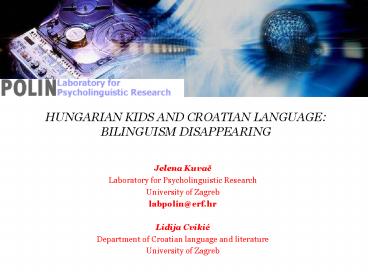HUNGARIAN KIDS AND CROATIAN LANGUAGE: BILINGUISM DISAPPEARING - PowerPoint PPT Presentation
1 / 11
Title:
HUNGARIAN KIDS AND CROATIAN LANGUAGE: BILINGUISM DISAPPEARING
Description:
changes of final -o in l (andeo-andela), collective nouns (cvijet-cvijeca) ... frequency of verb types (Larsen-Frieeman, 1976; ... – PowerPoint PPT presentation
Number of Views:32
Avg rating:3.0/5.0
Title: HUNGARIAN KIDS AND CROATIAN LANGUAGE: BILINGUISM DISAPPEARING
1
HUNGARIAN KIDS AND CROATIAN LANGUAGE BILINGUISM
DISAPPEARING
- Jelena Kuvac
- Laboratory for Psycholinguistic Research
- University of Zagreb
- labpolin_at_erf.hr
- Lidija Cvikic
- Department of Croatian language and literature
- University of Zagreb
2
Hungarian minority in Croatia
- 16.596 Hungarian people im Croatia
- 12.650 speak Hungarian as a mother-tongue
- Baranja ES Zmajevac (Vörosmarty) and ES Lug ?
east of Croatia
3
Some previous research
- The teachers estimated how children learn
Croatian (Vodopija, 2002.) - 1st grade listen
- 2nd grade comprehension
- 3th grade start to speak
- 4th grade either speak or dont ? they will
never speak - The 60 Hungarian children in Baranja in everyday
communication use only Hungarian language (Kuvac,
2002.) - The attitudes towards Croatian language are
negative (Kuvac, 2002.) - The number of language errors does not decrease
with age (the influence of inappropriates
educational demands) (Cvikic, Kuvac, 2003.)
4
General goalTo observe how children who speak
Croatian as L2 or foreign language acquire/learn
Croatian language and how they satisfy
educational demands
- SAMPLE
- 12 children ? 1st grade elementary school
Zmajevac and Kotlina - ?
- To get insight into lexical knowledge
- How they apply morphological rules?
5
Language tasks nonstandardized, working
materials
- Morphological Test
- Noun morphology
- Verb morphology
- Vocabulary Test
- Comprehension
- Production
6
RESULTS VOCABULARY TEST
- Comprehension
- Meat 91,6
- Star 91,6
- Hand 83,3
- Bird 83,3
- Fruit 83,3
- Bridge 75,0
- Knife 66,6
- Picture 66,7
- Wind 66,6
- Lake 41,6
- 75
- Production
- Cat 91,6
- House 66,6 ?
- Eye 25,0 ?
- Window 25,0 ?
- Tooth 16,6 ?
- Stone 25,0 ?
- Ear 16,6 ?
- Thief 8,3 ?
- Rope 0 ?
- River 0 ?
- 27,5
7
RESULTS MORPHOLOGY TEST
- Noun morphology
- masculina ? 19 different paradigmatics patterns
- voice changes
- sibilarization (vojnik-vojnici),
- palatalization (junak-junace),
- inconstant a (pas-psi),
- changes of final -o in l (andeo-andela),
- collective nouns (cvijet-cvijeca),
- short (konj-konji) and long (vlak-vlakovi)
plural
8
Overview of correct answers
- The same tendency in the acquisition of noun
morphology as in Croatian children - Nom Sing ? lexical problem
- Gen Sing ? repeat Nom Sing (cešalj) or they do
not apply voice changes (cešalja) - Nom Plu ? repeat Nom Sing (jastuk) produce new
forms but morphological incorrect
(jastuke), they do not apply voice changes
(jastuki) - Gen Plu ? repeat Nom Sing (pas) produce new
forms but morphological
incorrect (pasevi), they do not apply voice
changes (pas)
9
Verb morphology
- Some previous research have shown following
factors that influence the acquisition of
morphology - frequency of verb types (Larsen-Frieeman,
1976 - frequency of particular verb Ellis, 1996 and
others) - transparency of verb types (Dressler, 1998)
- complex morphology ? Croatian grammar 7
different verb types - 3 different verbs types according to the ralation
between infinitive and present forms (the
frequency criterium) - citati citAM
- raditi radIM
- plakati - placEM
10
Results
- Singular
- AM ? prototypical
- EM ? complex morphology but very frequent words
- (errors pišem ?pisam)
- IM ? the lowest results the lowest frequency of
verbs - (errors letim ? letem)
- Plural
- more incorrect answers than in singular
- Reason
- one more morphological rule
- IM ? i-e (radi-rade) (errors rade ?radiju)
- EM ? e u (piše-pišu) (errors pišu ?pisaju)
11
CONCLUSION
- Word comprehension is better than production ?
psycholinguistic rule (Barrett, 1995, Taylor,
1990) - Results of words production too low for
communication demands - Problems with noun and verb morphology ? lexicon
is base for morphology acquisition (Bates, 1997.)































